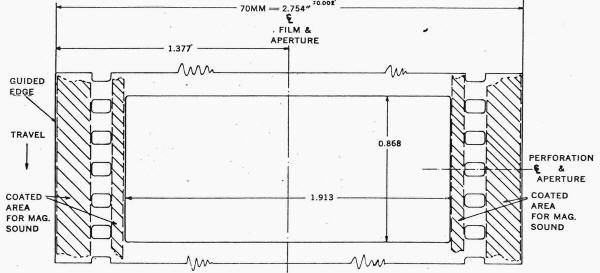Technical Information bulletin for "West Side Story" |
Read more at in70mm.com The 70mm Newsletter |
| From the Rayton collection, written by: United Artists Corp. | Date: 28.09.2020 |
Introduction |
|
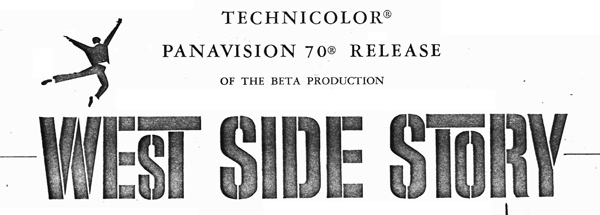 Technical Information bulletin From United Artists Corp. For the
Technicolor® Panavision 70® release of the Beta production "West Side Story". Technical Information bulletin From United Artists Corp. For the
Technicolor® Panavision 70® release of the Beta production "West Side Story".THE PRESENTATION of our picture "West Side Story" may find you faced with 70MM release problems for the first time. In order to assist you in the installation of 70MM projectors, as well as screens, screen masking, and sound considerations, the engineering department of United Artists has compiled technical information data in this brochure for your convenience. An outstanding feature is the screen chart which will facilitate the selection of proper focal length lenses for your screen size, all computed for the new 70MM projection aperture. A selection of easy-to-use formulas has also been provided in case your theatre requires deviation from the screen chart. A drawing showing the recommended aperture for 70MM projection has been included, as well as a drawing showing the sound track placement for the six magnetic tracks. We have also sup-plied information about the sound track, speaker arrangements, and theatre specifications. In "West Side Story" we are delivering to you unmatched entertainment on the finest release prints ever made. No amount of effort or expense was spared to achieve these goals. This motion picture deserves the finest presentation possible. We hope this technical bulletin will be of assistance. • PDF: Technical Information bulletin for "West Side Story" |
More in 70mm reading: PDF: Technical Information bulletin for "West Side Story" Original 6-track Mix Recovered and Restored for West Side Story Introduction to "West Side Story" This was a thrill Projection, sound and curtain cue sheets for "Exodus" 70mm Presentations - Letters from Directors 2001: A Space Odyssey Essential Presentation Procedure Internet link: |
Presentation |
|
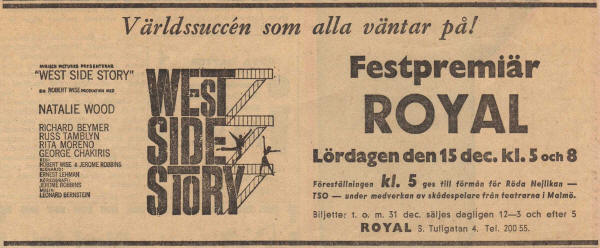 Although
you will undoubtedly have your own rehearsals with the picture
before your first public showing, the following procedure has been found
most ideal for the presentation of the picture and should be followed as
closely as possible. Although
you will undoubtedly have your own rehearsals with the picture
before your first public showing, the following procedure has been found
most ideal for the presentation of the picture and should be followed as
closely as possible.A special design has been created for the beginning of the picture over which the overture is played. It is of vital importance that the first 4˝ minutes of this design be projected with the house lights lowered by only 25%. For the proper presentation, please follow these directions:
|
|
Picture |
|
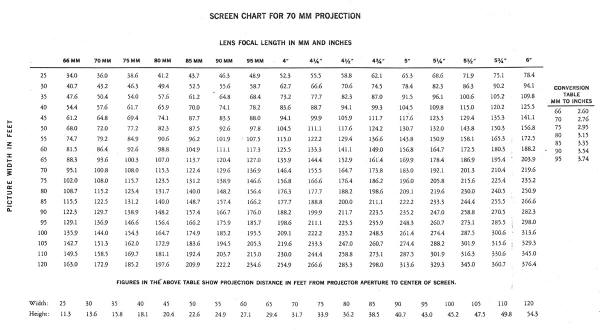 The screen chart on the opposite
page is especially calculated for the 70MM
projector aperture of 1.913 x 0.868 inches. The screen chart on the opposite
page is especially calculated for the 70MM
projector aperture of 1.913 x 0.868 inches.The aspect ratio is 2.21 to 1. This aperture was established by Todd-AO and is now a recommended SMPTE standard. The table shows picture widths - in the left and focal length of lenses in the top column. The figures in the table are -- distances from projector aperture to center screen in feet. The table below lists picture height to corresponding picture width based on a 2.21 to 1 aspect ratio. To the right of the main chart is an additional small table to relate corresponding focal length in millimeters to dimensions in inches-just for general orientation. Even though the tables are self-explanatory, for the calculation of specific installations, with given lenses, screen sizes, and throw, the usual formulas can be applied using the dimensions of the 70MM aperture: |
|
 |
|
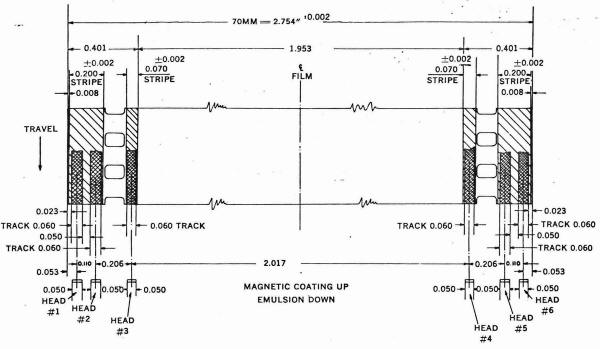 Important:
the focal length lenses listed in the top column are all available through
Panavision, Inc., 1917 Pontius Avenue, West Los Angeles, Calif., and are
lenses especially designed to cover the 70mm aperture. Only such lenses
should be used. Important:
the focal length lenses listed in the top column are all available through
Panavision, Inc., 1917 Pontius Avenue, West Los Angeles, Calif., and are
lenses especially designed to cover the 70mm aperture. Only such lenses
should be used.Do not project 70mm prints with lenses only suited for 35mm apertures - even if they have a 4" O.D. Do not project 70mm prints by using supplementary lenses, lens attachments, or focal length converting devices. THEY ALWAYS DETERIORATE PICTURE QUALITY AS COMPARED TO LENSES DESIGNED FOR THE JOB. |
|
 Motion
Picture Research Council, Hollywood Calif. 70mm test film chart Motion
Picture Research Council, Hollywood Calif. 70mm test film chartA 70MM projector alignment film with a test chart as shown below, should be used to check lens performance for cleanest and sharpest picture projection. This test film is available through supply houses and shipped with instruction sheet for its use. It can also be ordered from SMPTE, 55 West 42nd Street, New York 36, N. Y. |
|
Sound |
|
|
All
necessary test films for checking 6-channel magnetic sound installations, as
specified above, are available through the TODD-AO Corporation, West Coast
Division, 1021 North Seward Street, Hollywood, California. |
|
| Go: back - top - back issues - news index Updated 22-01-25 |

